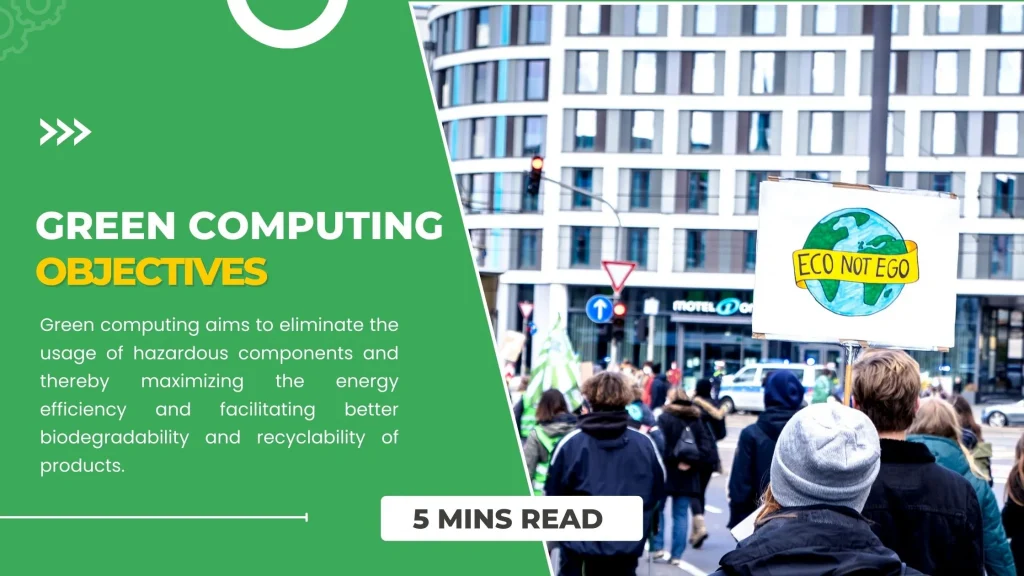Green Computing and its Objectives

Green computing, also known as green IT and sustainable IT emphasizes adopting environment-friendly practices that stress-reducing energy consumption and cutting down the waste that is being disposed of to the environment. The greatest negative impact of the increase in energy consumption is the accompanying increase in carbon emissions. All the equipment that makes up the physical infrastructure in a data center contributes their part that enhancing the overall carbon footprint. Nowadays, cloud computing service providers are stressing more and more the adoption of green and environment-friendly practices. Green computing stresses envisaging and adopting practices that enable in reduction of the carbon footprint.
One of the major driving factors to environmental problems is the multitude of business enterprises that have in-house data centers that house physical hardware and other devices whose operation can lead to the release of greenhouse gases. The electronic devices and other gadgets that are used in an office environment and their associated power consumption and wastage all contribute their part to this environmental problem. Thus reducing energy consumption is the need of the hour. Often it requires a world earth day or world environment day to serve as a reminder that highlights the need for green and environment-friendly practices.
Objectives of Green Computing
Green computing aims to eliminate the usage of hazardous components and thereby maximizing the energy efficiency and facilitating better biodegradability and recyclability of products. Green computing focuses on power management, recycling, virtualization, etc which can ultimately pave the way for a green and sustainable environment.
1) Recycling
Green computing initiatives promote better reusing and recycling of e-waste. It emphasizes adopting green initiatives as well as embracing environmentally friendly practices to enable recycling and reuse of components. E-waste recycling is a crucial process that cannot be overlooked. Recycling can eliminate the damage that is inflicted on the environment by encouraging the use of biodegradable materials and reducing non-biodegradable materials like plastic. E-waste refers to the redundant, retired, and non-functional electronic devices like laptops, personal computers, mobile phones, and tablets.
These electronic devices are composed of different components like metals based on copper and lead. When the life cycle of the component expires, these are thrown away. Recycling the materials of which these devices are made can eliminate their drastic impact on the environment.
2) Enable Organizations to Meet Their Sustainability Goals
An on-premise data center consumes more energy and enhances the emission of gases like carbon dioxide. Migrating from on-premise infrastructure to the cloud enables organizations to cut down their energy requirements. As per an IDC report, green cloud datacenters enable enterprises to save up to 629 million metric tons of greenhouse gases by about 2025. The US Environmental Protection Agency’s (EPA) Energy Star program is a step in this direction. The Energy Star program emphasizes promoting energy-efficient practices. This program gives information regarding the energy consumption of devices and products using different standardized methods.
3) Minimize the Cost
A proper cloud utilization strategy apart from enabling you to cut down the energy requirements can also help you to cut down the cost and server utilization, and also paves the way to better workload flexibility. Cloud technology thus facilitates better cost savings as compared to on-premise infrastructure. The computers and other processing devices that are available today are much energy efficient and can not only cut down the consumption of energy but also pave the way to better cost savings and management. Instead of keeping your computing devices on throughout, you can put these devices in sleep mode which helps you to cut down the cost overheads as well as save power.
4) Algorithmic Efficiency
Algorithmic efficiency intends to optimize the consumption of power by making an algorithm more efficient. It emphasizes bringing down the number of resources that are required for implementing functionalities. Proper allocation of resources for computing can enable organizations to cut down their costs. An efficient algorithm is one that consumes resources at a level that is below the acceptable level and should also be executed in a reasonable amount of time.
5) Virtualization
Virtualization is a technique that is used to resolve the issue of power consumption. Virtualization emphasizes better and more efficient use of resources by redesigning the various components and hardware. From the perspective of data centers, virtualization involves the installation of virtual infrastructure that stresses bringing down the number of servers. The reduction in the number of servers can enable a reduction in the size of the facility that is used to house all the components. Virtualization can enable companies to reduce downtime by moving the virtual machine from the current server to another. It enables you to dynamically manage and balance the workloads across server groups and facilitate automatic failover for virtualized applications.
6) Remote Work Capabilities
Remote Work Capabilities can reduce the environmental footprint.
Cloud computing facilitates remote and hybrid work environments that enable the employees of an organization to work from anywhere. Apart from providing enhanced flexibility to the employees as well as enabling an organization to eliminate costly overheads, there is an environmental component that is present in the cloud as well. Remote working practices enable an organization to adopt smaller office spaces and eliminate the need to reserve any infrastructure for the employees. This can drastically cut down the carbon footprint. Employees need not commute to and from their office thus reducing the reliance on vehicles which further cut down the emission of greenhouse gases.
This can be very crucial for developing countries in their initiatives to embrace eco-friendly practices.
How Can an Organization Adopt Environmental Friendly Practices?
1) Automated control of electrical equipment that enables the auto-switching of electrical components.
2) Adopt cloud computing capabilities that enable an organization to do away with the need to manage and maintain physical servers.
3) Investing in energy management software can help enterprises to check on their energy management by setting alarms that help them to receive automatic notifications whenever their consumption exceeds a preset level.
4)Energy audits can help enterprises to find those areas where the usage of energy is critical and take appropriate actions that could enable enterprises to cut down their energy usage.
5)Data centers now rely on renewable energy operations like using recycled waste heat that enables businesses and nearby households to heat the water.
Submerged underwater data centers require data to travel a shorter distance thus leading to fast operations like video streaming, and web surfing.
Conclusion
Environmental and sustainability goals cannot be achieved overnight. It requires continuous, cohesive, dedicated, and perseverant efforts from all the individuals, government and private organizations, and multinational corporations and companies. Sustainable environment goals should be a priority for each and every individual in this world who shares this earth with other inhabitants.
Activelobby provides cloud management and migration services. If you are looking to adopt the cloud as the first step to energy efficiency and sustainable development goals, you can avail yourself of our migration services.
